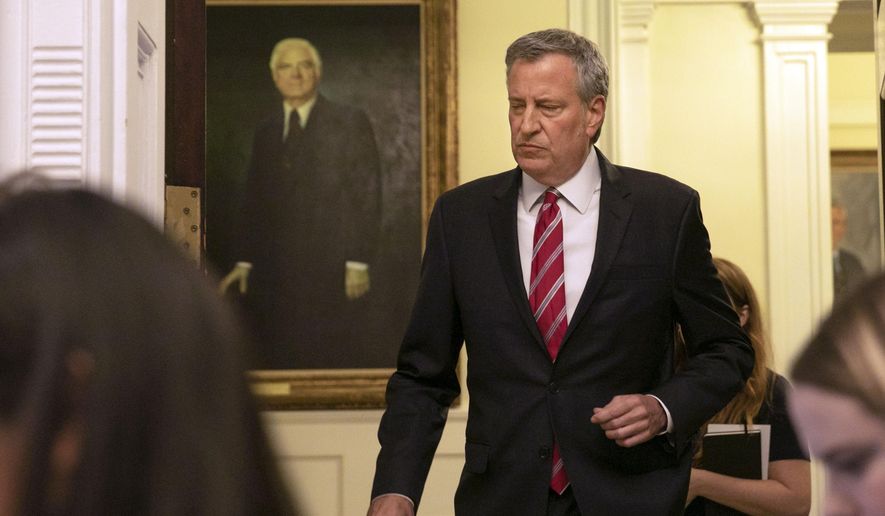NEW YORK (AP) - Mayor Bill de Blasio’s relationship with New York City’s police force was destined to be rocky. He took office promising to overhaul how the city’s 36,000 officers interacted with the public, especially people of color.
But Blasio’s handling of one such interaction - the 2014 police killing of Eric Garner - permanently poisoned his standing not only with officers, but also many of the police reform activists who helped get him elected.
The ill will on both sides was apparent again Monday, when the department, after five years of delays, fired the officer who used a banned chokehold to wrestle Garner to the ground during an arrest over alleged sales of untaxed cigarettes.
Reform advocates welcomed the decision, but criticized de Blasio for allowing Officer Daniel Pantaleo to remain on the force for years after video showed Garner gasping “I can’t breathe” as the officer cut off his airflow.
The head of the city’s largest police union, meanwhile, angrily declared that officers had been “abandoned” by a mayor and police commissioner who are “absolutely afraid of the criminal advocates.”
“The leadership has abandoned ship and left our police officers on the street alone, without backing,” said Pat Lynch, president of the Police Benevolent Association, standing in front of a police department flag that had been hung upside down.
Neither criticism is new for de Blasio, who is now seeking the Democratic presidential nomination.
Chants of “Fire Pantaleo !” interrupted de Blasio at a Democratic candidate presidential debate late last month in Detroit. The same chants rang out two days later at City Hall as de Blasio spoke to reporters after a police department administrative judge, in a precursor to Monday’s decision, recommended that Pantaleo lose his job.
And police union criticism of de Blasio dates back to before his election, but hit a fever pitch in December of 2014, when two officers were killed by a disturbed gunman angry about police killings of unarmed black men. Lynch at the time said City Hall had “blood on his hands,” and some officers began turning their backs on the mayor when he spoke at police funerals.
The police unions, angry with de Blasio over myriad issues including officers’ pay, have chased him around the country on the presidential campaign with mobile billboards and newspaper ads.
Since taking office, de Blasio has tried to walk a line between promising reforms - like ending a police tactic of stopping and searching huge numbers of mostly black and Hispanic men for weapons - and assuring rank-and-file police officers that they have his support.
The mayor tried again after Police Commissioner James O’Neill announced that Pantaleo had been fired, saying he thought the NYPD had changed “profoundly” since Garner’s death, and that its officers were people who had made “a good and noble choice to serve others, to protect others.”
“To our officers - a simple statement: We need you and we need you to build deeper trust with all the people you serve,” he said, “Because that is not only the right thing to do, it is the best way to keep everyone safe, officers and civilians alike.”
In the initial aftermath of Garner’s death, de Blasio spoke critically of the officers involved. He called bystander video of the confrontation between the white officers and Garner, who was black, “very troubling” and “very sad to watch.”
Then, in a move that upset Garner’s family and police reform activists, the city held off on any potential police department punishment for the officers, other than desk duty, while federal prosecutors conducted a lengthy civil rights investigation.
“He’s been trying to have both sides of it,” Iona College political science professor Jeanne Zaino said of de Blasio. “He again appears to be two-faced.”
“As mayor of New York City, it is incredibly important that he’s supportive of law enforcement and the work that they’re doing. And yet, by the same token, he has run against them and wants to continue running against them not just for mayor but nationally.”
In a one-two punch soon into his tenure, de Blasio boosted his bona fides with reformers by dropping the city’s appeal to a ruling that curbed officers’ use of “stop and frisk,” tactics.
Then he irritated the reformers with an old-school choice for police commissioner: Bill Bratton, who previously held the job in the mid-1990s under former Mayor Rudy Giuliani, a Republican, and is credited with popularizing a strategy of cracking down on minor offenses as a way of ensuring public order.
“In spite of the fact that de Blasio in many ways won his election arguably on a police reform platform, he has not really done the meaningful reforms that need to happen,” said Joo-Hyun Kang, the director of Communities United for Police Reform. “He’s actually been an obstructionist more than someone who was actually championing change.”
Pantaleo’s lawyer and his union, contend that the officer won on the evidence at a seven-day department disciplinary trial, but political pressure made his firing inevitable. They have promised a legal challenge to his firing.
Pantaleo’s firing Monday came at a time when de Blasio was already under fire from police unions for his response to recent videos posted on social media showing people pouring buckets of water on uniformed patrol officers.
De Blasio called the soakings “unacceptable,” but union officials said that police reform policies of de Blasio and other liberal politicians had created a climate of disrespect for officers on the beat.
President Donald Trump tweeted that the mayor needed to “STAND UP for those who protect our lives and serve us all so well.” The mayor fired back: “Crime’s gone down year after year in New York City and it’s not just because you finally left town.”
__
Follow Michael Sisak at twitter.com/mikesisak and Tom Hays at twitter.com/APtomhays




Please read our comment policy before commenting.